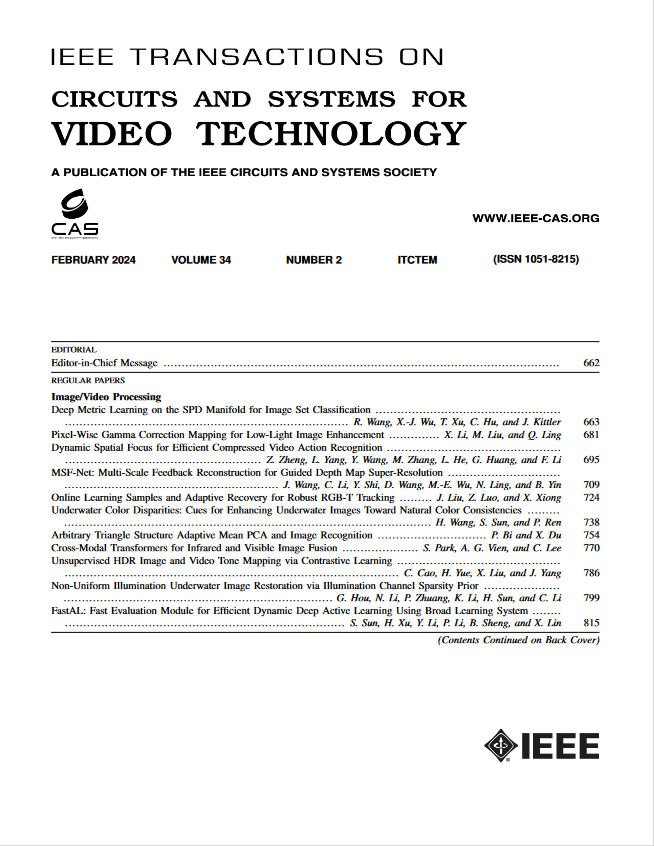Hierarchical Frequency-Based Upsampling and Refining for HEVC Compressed Video Enhancement
IF 8.3
1区 工程技术
Q1 ENGINEERING, ELECTRICAL & ELECTRONIC
IEEE Transactions on Circuits and Systems for Video Technology
Pub Date : 2024-12-16
DOI:10.1109/TCSVT.2024.3517840
引用次数: 0
Abstract
Video compression artifacts arise from quantization applied in the frequency domain. Video quality enhancement aims to reduce such compression artifacts and reconstruct a visually pleasant result. While existing methods effectively reduce artifacts in the spatial domain, they often overlook the rich frequency domain information, especially in addressing multi-scale compression artifacts. This work introduces a frequency-domain upsampling strategy within a multi-scale framework, specifically designed to focus on high-frequency details rather than simply blending neighboring pixels during the upsampling process. Our proposed hierarchical frequency-based upsampling and refinement neural network (HFUR) consists of two modules: implicit frequency upsampling (ImpFreqUp) and hierarchical and iterative refinement (HIR). ImpFreqUp exploits the DCT-domain prior derived through an implicit DCT transform, and accurately reconstructs the DCT-domain signal via a coarse-to-fine transfer. Additionally, HIR is introduced to facilitate cross-collaboration and information compensation between the scales, further refining the feature maps and promoting the visual quality of the final output. We demonstrate the effectiveness of the proposed modules via ablation experiments and visualized results. Experimental results demonstrate that HFUR outperforms the state-of-the-art methods up to 0.13dB/0.17dB on both constant bit rate and constant QP modes. The code is available atHEVC压缩视频增强中基于分层频率的上采样和细化
视频压缩伪影是在频域进行量化产生的。视频质量增强的目的是减少这种压缩伪影,重建一个视觉上令人愉快的结果。虽然现有的方法可以有效地减少空间域的伪影,但往往忽略了丰富的频域信息,特别是在处理多尺度压缩伪影时。这项工作在多尺度框架内引入了一种频域上采样策略,专门设计用于在上采样过程中关注高频细节,而不是简单地混合相邻像素。我们提出的基于层次频率的上采样和细化神经网络(HFUR)由两个模块组成:隐式频率上采样(ImpFreqUp)和层次迭代细化(HIR)。ImpFreqUp利用隐式DCT变换得到的DCT域先验,通过粗-细转换精确重建DCT域信号。此外,引入HIR可以促进尺度之间的交叉协作和信息补偿,进一步细化特征映射,提高最终输出的视觉质量。我们通过烧蚀实验和可视化结果证明了所提出模块的有效性。实验结果表明,在恒定比特率和恒定QP模式下,HFUR的性能都优于最先进的方法,最高可达0.13dB/0.17dB。代码可在https://github.com/zqqqyu/HFUR上获得。
本文章由计算机程序翻译,如有差异,请以英文原文为准。
求助全文
约1分钟内获得全文
求助全文
来源期刊
CiteScore
13.80
自引率
27.40%
发文量
660
审稿时长
5 months
期刊介绍:
The IEEE Transactions on Circuits and Systems for Video Technology (TCSVT) is dedicated to covering all aspects of video technologies from a circuits and systems perspective. We encourage submissions of general, theoretical, and application-oriented papers related to image and video acquisition, representation, presentation, and display. Additionally, we welcome contributions in areas such as processing, filtering, and transforms; analysis and synthesis; learning and understanding; compression, transmission, communication, and networking; as well as storage, retrieval, indexing, and search. Furthermore, papers focusing on hardware and software design and implementation are highly valued. Join us in advancing the field of video technology through innovative research and insights.

 求助内容:
求助内容: 应助结果提醒方式:
应助结果提醒方式:


